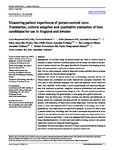Measuring patient experiences of person-centred care: cultural adaption and qualitative evaluation of item candidates for use in England and Sweden
| dc.contributor.author | Roselund, L | |
| dc.contributor.author | Jackobsson, S | |
| dc.contributor.author | Nilsson, A | |
| dc.contributor.author | Lloyd, Helen | |
| dc.contributor.author | Dencker, A | |
| dc.date.accessioned | 2021-05-04T14:20:35Z | |
| dc.date.issued | 2021-05-04 | |
| dc.identifier.issn | 0283-9318 | |
| dc.identifier.issn | 1471-6712 | |
| dc.identifier.uri | http://hdl.handle.net/10026.1/17082 | |
| dc.description.abstract |
<jats:title>Abstract</jats:title><jats:sec><jats:title>Background</jats:title><jats:p>To facilitate change for person‐centred care, there is a need to invest in measures to assess if and how healthcare systems are delivering care based on the principles of person‐centred care. This paper describes the first phase in developing an item bank to measure patients’ experiences of person‐centred care.</jats:p></jats:sec><jats:sec><jats:title>Aim</jats:title><jats:p>The aim was to translate, culturally adapt and evaluate candidate items to measure person‐centred care from the patient's perspective.</jats:p></jats:sec><jats:sec><jats:title>Methods</jats:title><jats:p>The Centre for person‐centred care at Gothenburg university and the UK Person‐centred and coordinated care model informed our conceptual framework. The initial pool of item candidates originated from a previous systematic review where 855 items were identified. In this study, a mixed method design was used involving persons with experience as patients, caregivers, healthcare professionals and researchers in person‐centred care or questionnaire design (n = 84). The item analysis included two validation rounds using web questionnaires, a focus group and cognitive interviews.</jats:p></jats:sec><jats:sec><jats:title>Results</jats:title><jats:p>From the initial pool, 155 items covering core domains and subdomains of person‐centred and coordinated care were selected for translation and qualitative item analysis. After translation, 44 items were excluded (duplicates). After the first validation round, 21 items were rephrased and 35 were excluded (due to low ratings, lack of comprehensibility, were duplicates or too specifically phrased). To reflect the ethical basis of person‐centred care, rewordings were also made to encompass the patient as an active partner in care and where communication and information goes two‐ways and care is co‐created. After the second round, 11 items were rephrased and 25 items were excluded (for being redundant/repetitive). Six new items were added (covering access to care, patient capabilities, mental well‐being and identifying goals).</jats:p></jats:sec><jats:sec><jats:title>Conclusion</jats:title><jats:p>We have developed a first set of 57 items to proceed towards developing an item bank to measure the patient experiences of person‐centred care.</jats:p></jats:sec> | |
| dc.format.extent | 235-244 | |
| dc.format.medium | Print-Electronic | |
| dc.language | en | |
| dc.language.iso | en | |
| dc.publisher | Wiley | |
| dc.subject | person‐ | |
| dc.subject | centred care | |
| dc.subject | patient‐ | |
| dc.subject | reported experience measures | |
| dc.subject | qualitative item evaluation | |
| dc.title | Measuring patient experiences of person-centred care: cultural adaption and qualitative evaluation of item candidates for use in England and Sweden | |
| dc.type | journal-article | |
| dc.type | Journal Article | |
| plymouth.author-url | https://www.webofscience.com/api/gateway?GWVersion=2&SrcApp=PARTNER_APP&SrcAuth=LinksAMR&KeyUT=WOS:000646651800001&DestLinkType=FullRecord&DestApp=ALL_WOS&UsrCustomerID=11bb513d99f797142bcfeffcc58ea008 | |
| plymouth.issue | 1 | |
| plymouth.volume | 36 | |
| plymouth.publication-status | Published | |
| plymouth.journal | Scandinavian Journal of Caring Sciences | |
| dc.identifier.doi | 10.1111/scs.12982 | |
| plymouth.organisational-group | /Plymouth | |
| plymouth.organisational-group | /Plymouth/Faculty of Health | |
| plymouth.organisational-group | /Plymouth/Faculty of Health/School of Psychology | |
| plymouth.organisational-group | /Plymouth/REF 2021 Researchers by UoA | |
| plymouth.organisational-group | /Plymouth/REF 2021 Researchers by UoA/UoA04 Psychology, Psychiatry and Neuroscience | |
| plymouth.organisational-group | /Plymouth/Research Groups | |
| plymouth.organisational-group | /Plymouth/Research Groups/FoH - Community and Primary Care | |
| plymouth.organisational-group | /Plymouth/Research Groups/Institute of Health and Community | |
| plymouth.organisational-group | /Plymouth/Research Groups/Institute of Translational and Stratified Medicine (ITSMED) | |
| plymouth.organisational-group | /Plymouth/Research Groups/Institute of Translational and Stratified Medicine (ITSMED)/CCT&PS | |
| plymouth.organisational-group | /Plymouth/Research Groups/Plymouth Institute of Health and Care Research (PIHR) | |
| plymouth.organisational-group | /Plymouth/Users by role | |
| plymouth.organisational-group | /Plymouth/Users by role/Academics | |
| dc.publisher.place | Sweden | |
| dcterms.dateAccepted | 2021-03-07 | |
| dc.rights.embargodate | 2021-5-6 | |
| dc.identifier.eissn | 1471-6712 | |
| dc.rights.embargoperiod | Not known | |
| rioxxterms.versionofrecord | 10.1111/scs.12982 | |
| rioxxterms.licenseref.uri | http://www.rioxx.net/licenses/all-rights-reserved | |
| rioxxterms.licenseref.startdate | 2021-05-04 | |
| rioxxterms.type | Journal Article/Review | |
| plymouth.funder | Methodological solutions to support the Assessment of Individualised Care: The Mosaic Project.::University of Gothenburg Centre for Person Centred Care) |


